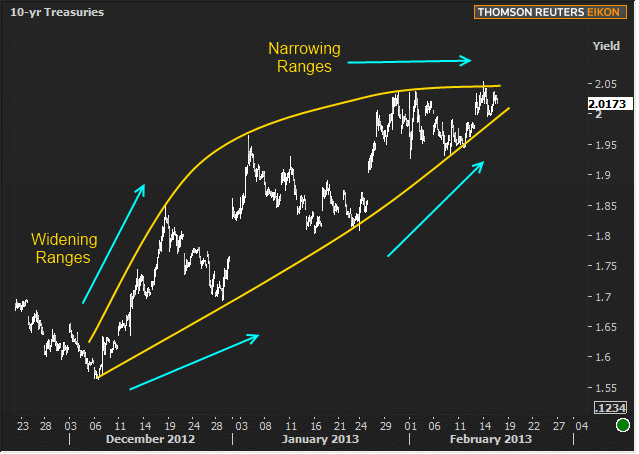Mortgage rates moved modestly higher for some lenders today, while others remained closer to unchanged territory. Following Wednesday's swing to 6-month highs, this leaves the average rate sheet somewhere between there and yesterday's. In terms of the actual interest rate, 3.625% remains as the most prevalent "best-execution" rate, with relatively small adjustments in costs vs yesterday. Market movements during US trading hours have been relatively subdued for mortgage-backed-securities, or "MBS," that most directly affect rates (Wednesday's drama happened overnight in European trading hours. MBS opened much weaker, but didn't move as much during domestic hours).
(What is A Best-Execution Mortgage Rate?)
The recent trend of relative containment of trading ranges during domestic hours continued today, which is a welcome change of pace vs late January volatility. It's not that we haven't seen volatility recently, simply that it's not on the same scale as the last round that took us so quickly to multi-month highs. The current volatility is merely adjusting the closing cost side of the home loan equation whereas previous volatility moved the actual interest rate side.
Looking beyond mortgage rates to broader bond markets, we see February, thus far, has been characterized by a clear compression of extremes. In other words, the ranges of movements and the outright increases have been relatively smaller since the sharper moves in late January. Really, this is just another way to say that volatility is decreasing. This chart of 10yr Treasury yields gives an idea of that phenomenon hour by hour.

Of course we'd be the first to point out that Treasury rates don't always indicate mortgage rates, but the movement over this time frame is generally similar. When we see markets consolidating like this is can suggest that the conflict between "higher vs lower" will make for a brisker tailwind for the victor of that argument. In other words, things have been calm (relatively), but they look close to making a bigger move, either back down to 3.5% or firmly up to 3.75% in terms of Best-Execution 30yr rates.
Loan Originator Perspectives
"Markets bleeding off yesterday's gains as the day progresses. Especially with Monday's holiday, the possibility of worsened prices this PM are very real. My advice for my clients has always been "if the pricing works, take the money and run", so will be locking deals that fit this today. What I don't want to do is promise my clients pricing today that may not be available when the market reopens on Tuesday!" -Ted Rood, Senior Originator, Wintrust Mortgage.
"My advice today is pretty much the same as yesterday. If i was buying a home and closing in the next 30 days, i would lock and remove all risk. If i was refinancing and didn't lock yesterday, i would continue to rolling the dice until Tuesday. The trend has been and continues to point toward higher rates, so float at your own risk." -Victor Burek, Open Mortgage
"We are still in full on lock mode. You can't fight the current trend of slowly drifting higher rates. Until we see something different, we are protecting our customers with a lock at application." -Alan Craft, Acopia Home Loans.
Today's Best-Execution Rates
- 30YR FIXED - 3.625%
- FHA/VA - 3.25% - 3.5% (varies more between lenders than conventional 30yr Fixed)
- 15 YEAR FIXED - 2.875%- 3.00%
- 5 YEAR ARMS - 2.625-3.25% depending on the lender
Ongoing Lock/Float Considerations
- Rates have risen moderately from their all-time lows, making for relatively increased reward for floating at the expense of greater risks of loss.
- Rates could easily move higher or lower, and unscheduled, unexpected events can ultimately have the most say in the direction.
- Near term risks in 2013 include the upcoming debt-ceiling debate in Washington as well as the Fed's policy outlook regarding securities purchases.
- Prospects For Extending The Debt Ceiling Deadline currently seem to be preventing a move back down in rate. Passage of such legislation could further support a rising rate environment.
- (As always, please keep in mind that our talk of Best-Execution always pertains to a completely ideal scenario. There can be all sorts of reasons that your quoted rate would not be the same as our average rates, and in those cases, assuming you're following along on a day to day basis, simply use the Best-Ex levels we quote as a baseline to track potential movement in your quoted rate).




